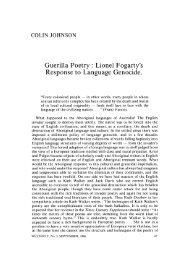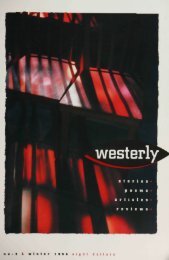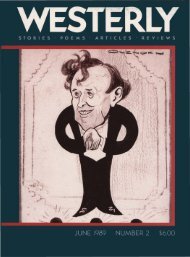For a personal view. <strong>Westerly</strong> asked Henrietta Drake-Brockman,who was away from Perth during the later stages of the controversy.AN ARCH TO BE PROUD OFH. DRAKE-BROCKMAN.Now scantier limits the proud arch confine.And scarce is seen the prostrate Swan divine;The Mitchell Freeway thro' the piece is roll'd.Our birthright for a maze of asphalt sold.ALEXANDER POPE is to be thanked forpublishing in his Moral Essays a verse so aptto my twisting, filched from his Epistle to MrAddison on the Substitution of Medals forArches.My own concern is the suggested substitutionof Obelisk or Fountain for one halfdemolishedArch.Medals and Arches both remain symbols ofVictory, take your choice; but not the wildestflight of imagination can possibly twist obeliskor fountain to symbolise the Past which theOld Barracks represented to the people ofPerth. Certainly it was not a matter of victory,unless in the third colonial period the buildingwas viewed as a mark of triumph when theshape of a City begun with an axe-blow byMrs Dance, at last became visible. More likelyit then symbolised Protection; from outsideaggressors or inside rioters. Or perhaps—andwho at this distance can tell?—it stood as ahappy reminder of London and St James'sPalace.No citizen of Perth visiting the Old Countrycould have failed to notice the resemblance(that was) between the Old Barracks Archwayand the Tudor Gateway designed for HenryVlll by Holbein as a front entrance to thatmonarch's new palace. The Barracks, morethan any other building here, was a bit ofOld England in a colonial setting.The symbol should never have been destroyedin the dubious track of Progress. Thetwo turrets and the twin faces of the wings(with side extensions removed) should haveremained as a gracious and substantial memorialto Early Perth, beautifully placed, neithertoo large nor too insignificant. Such a buildingwould have been ideally suited for use as aMuseum of the City of Perth and Town Archives.Similar specialized museums exist in all tbemajor cities of the world; and none would havebeen more suitable, more elegant, more historicallysited to its purpose than the lostBarracks to us.Well, the building has gone. What is to bedone about the lonely Arch?Let me say at once that I am neither sentimentalnor passionately emotional on thismatter. And for a very sound reason: I wasbrought up to expect the Barracks to disappear,in the belief that one day I should be able tolook up the sweep of St George's Terrace to aParliament House of dignified architecturalbeauty crowning the hill, reached by terracesof broad stairs in the Roman manner, withfountains sparkling in a square at the foot.My father's minute apropos the building ofthe new House was read aloud in the oldChamber (then situated in rented premises adjacentto the Town Hall), by the Hon. WalterKingsmill, the Minister for Works. My father—Martin JuU—was then Undersecretary forWorks. To his lot had fallen the drawing upand announcement of a competition authorisedby Parliament, in which, above my father'ssignature, the Director of Works invited designsfor "new Houses of Parliament at Perth."Everyone hoped the finished building would be—as Sir John Forrest had expressed his ownwish some years earlier—"as convenient, asbeautiful, and even as splendid as possible."The first prize was £500, with two lesserprizes. Seventeen designs were submitted fromall over Australia and abroad. However, allappeared to exceed the specified sum of£100,000 to which competing architects hadbeen limited. Before laying the plans beforethe House, State architects had been consulted;and my father's minute showed that the partwe now know as the Harvest Terrace portion,could be locally designed and constructed forpossibly £20,000, certainly for £25,000; then, inthe fulness of time, the front facade, facing theCity, could be added at leisure; or when theTreasury was in funds. But the high spot ofthat minute demonstrated to delighted Membersthat it would be possible to build a commodiousand excellent building to house bothCouncil and Assembly (then divided, with resultingdiscomfort) under one roof and, at thesame time, by saving rent and maintenance onthe various premises then in use, actually gaina sum of £255/16/2 per annum. The intereston capital expenditure, it appeared, would beless than the current outgoings.62 WESTERLY, No. 1 of 1967
Any doubts on the wisdom of beginning immediatelyto build a new House were at onceforgotten!While that session was in progress, I wasdoubtless asleep in my cot on the wide balconyof the house where I was born, overlookingthe Swan River from Bellevue Terrace. I'vebeen told it was the first house to be builtthere; certainly I possess a photograph takenfrom Mount's Bay road (or rather track!), thatshows it sticking up against the sky like theproverbial thumb, quite solitary. Family legendrelates that my father's friends thought himdemented to build there—^Adelaide Terrace wasthe residential area. But his disconcertingchoice has left me with a very special attachmentto the River my infant eyes more or lessopened on (they say stock always seek for thewaters beside which they are born). However,we moved from there, and my father movedfrom the Department of Works to become theState's first Public Service Commissioner.Nevertheless, on a number of occasions I wasshown the finished design for Parliament Housethat had been drawn by the Government Architect,Mr H. L. Grainger. His was the designfinally accepted, and the first stage had soonbeen constructed.Unrolled for my benefit, the great plansappeared to me quite marvellous. (Certainly,studied today, Mr Grainger's designs are farmore suitable and elegant than the first, secondand third chosen from those submitted. Althoughnone were accepted, the Governmentdistributed half the prize money.) From thattime on, I always looked up the Terrace withsome glorious fairy-tale structure or KublaKhan Dome, in my mind's eye. When I grewup, I simply replaced my childish vision by aHouse of dignified and elegant classical beauty.Something gloriously simple and austere in thestyle of the Parthenon, I suppose—which I nowknow is more sublime than any photographcan show, largely because its elevated positionadds the subtle magic of changing light andshade to impeccable proportions.After my father's death, my mother and Ilived in Malcolm St. Up and down I walked,mostly three times a day, throughout my teenageyears. I took a dislike to the Barracks,then. The back view offended me; even morethan the dangling hoop-iron bond-strips stillhopefully protruding (seventeen years on)from the unfaced brick walls on the hill above,all ready to be joined up to what I still believedwould one day take form: a beautifulfront facade to Parliament House.The Barracks back view was, in fact, quiteslummy. All it lacked were strings of ghostlysoldiers' ghostly socks hanging out to dry. Butno one seemed to mind that depressing view,if they even noticed it—backviews withskiUions and wooden whatnots were part ofthe Western Austrahan scene at that time.But I also became more intimate with MrGrainger's Harvest Terrace facade to theHouse. I was asked to paint a water-colourminiature to adorn an Illuminated Addresspresented by some Associates (I cannot recallwhich) to Mrs Edith Cowan, O.B.E. who onher election to our Legislative Assembly becamethe first woman Member to sit in an AustralianParhament. Later still, one of the beautifulfront rooms situated in the turrets of theOld Barracks, became my husband's office inthe Public Works Department. I often enoughwas able to enjoy looking out, right down theTerrace, to the blue and purple of the DarlingRange. (Fortunately, the back parts had beensomewhat tidied up and painted, by then.)So one way and another, the Houses of Parliamentand the Old Barracks became closelyassociated with my view of Perth, both in factand in imagination.And now the Front has been added to theHouse.While it was still building, I retained hopes.Once built, planted above the City like a thriftynest of pigeon-holes (inside, I may say, thedesign is as attractive as outside it is strictlyutilitarian, so that Members, beguiled, may forgetthe public view)—once built, my dreamsdissolved in commonplace reality. I turnedmy interest to the preservation of the Barracksas a City of Perth Museum, a screen as itv/ere, of historical significance.When eventually public outcry alone savedthe old building from total destruction, wehappened to be absent in Europe. And in fairnessI must acknowledge that when on returnI saw the scanty remnant of our once-proudArch, I cried out, "Oh no! Now the soonerthat goes, the better!"After all, I was fresh from the Arc deTriomphe in Paris, the Wellington MemorialArch in London, Constantine's Arch in Rome,Hadrian's in Athens, Washington's in NewYork, even the worn yet splendid Arch ofGalerius in Salonika; not all seen in a singlepilgrimage, but near enough. Near enough forme to have a vision of proud arches. (Besides,Constantine's Arch in Rome has a very specialinterest for me, and possibly for other WesternAustralians: the beautiful and world-famousCameo, a Medal of a sort, that was carriedashore away back in 1629 from the wreckedNetherlands ship Batavia to rest for months onBeacon Island in the Wallaby Group of theWESTERLY, No. 1 of 1967 63
- Page 1 and 2:
arc de triomphe
- Page 3 and 4:
westerlya quarterly reviewEDITORIAL
- Page 5:
westerlyNo. 1 of 1967CONTENTSSTORIE
- Page 8 and 9:
"Oh, old Jack's morals are alright
- Page 10 and 11:
were looking down on a face so scru
- Page 12 and 13:
in the comfort of cars. Ellie and T
- Page 14 and 15:
grand, final fling. His bright eyes
- Page 16 and 17:
The rotting wood in the window fram
- Page 18 and 19: John lumbered up the steps of the G
- Page 20 and 21: night storm that flashed and twinkl
- Page 22 and 23: Quietly the young man left to fetch
- Page 24 and 25: "Bother, I've forgotten your aktavi
- Page 26 and 27: patiently as she hesitated. What wa
- Page 28 and 29: THEUNIVERSITYBOOKSHOPAT THE UNIVERS
- Page 30 and 31: PREFACE(Emaux et Camees)Pendant les
- Page 32 and 33: NOELLe ciel est noir, la terre est
- Page 34 and 35: LA DERNIERE FEUILLEDans la foret ch
- Page 36 and 37: LES COLOMBESSur le coteau, 1^-bas o
- Page 38 and 39: LA MONTREDeux fois je regarde ma mo
- Page 40 and 41: FUMEELa-bas, sous les arbres s'abri
- Page 42 and 43: PENDANT LA TEMPETELa barque est pet
- Page 44 and 45: PAYSAGEPas une feuille qui bouge,Pa
- Page 46 and 47: LE MERLEUn oiseau siffle dans les b
- Page 48 and 49: LETRILLAEnfant, pourquoi tant de pa
- Page 50 and 51: L'ARTOui, I'oeuvre sort plus belleD
- Page 52 and 53: ARTYes, lovelier do works of artEme
- Page 54 and 55: Some JOURNALS published byUNIVERSIT
- Page 56 and 57: But the two Town Planners did not j
- Page 58 and 59: The years 1963-65, therefore, were
- Page 60 and 61: COCD00(Moasu;-(a!CocP4Q
- Page 62 and 63: •OS. ^ " ^-«w" 1 a 1-1* r^^ril1
- Page 64 and 65: —representing one home in about 5
- Page 66 and 67: ingly in the determination of its p
- Page 70 and 71: Abrolhos Islands, is believed to ha
- Page 72 and 73: added dimension of individual human
- Page 74 and 75: and feelings of his people or of th
- Page 76 and 77: theological developments of the las
- Page 79 and 80: IF YOU DON T KNOW HOWDON'T DO IT•







